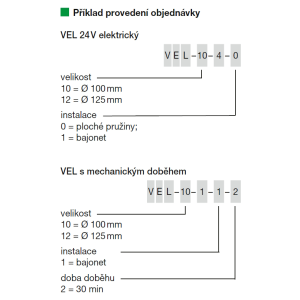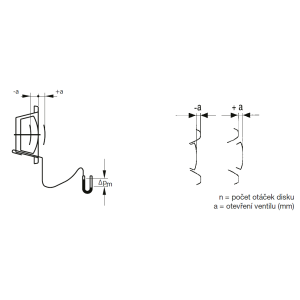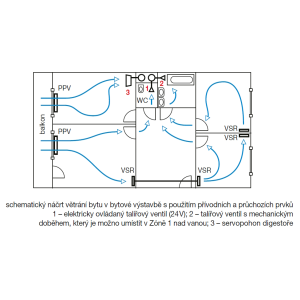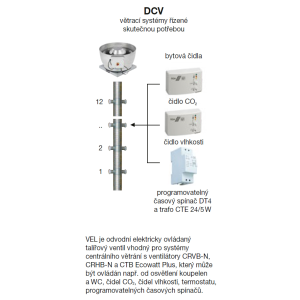Specified for air discharge (supply), with adjustable centre element for flow control. The valves are made of polypropylene, colour white (RAL9003), sealing to the frame with elastic tape. Mounting frames are made of galvanized sheet metal. \
- electric control 24 V (4 W)
- protection IP 61
- mechanical with timer for DCV systems (ventilation controlled by actual need)
- suitable for renovation of prefabricated houses without the need for intervention in the HVAC distribution system
- min. flow adjustment by turning the disc
- low noise and crosstalk values
- ambient temperature up to 100 °C
Installation
The valves are inserted into the mounting frame, which is not included. The mounting frame is used to fix the valve to the ceiling structure, to the wall or to a circular pipe. By rotating the centre disc, the minimum continuous flow rate of the closed valve can be adjusted. In the mechanical version, a minimum opening of approx. 20 l/s is required to ensure the run-out time.
Mounting frames
VLZ-03-10, VLZ-03-12 - without rubber seal, for valves with bayonet
VLZ-06-10, VLZ-06-12 - without rubber seal, for valves with flat springs
Use
VEL electrically operated plate valves are suitable for DCV (demand controlled ventilation) systems. The systems operate on the principle of controlling to a constant riser pressure. A CTE 24/5 W transformer is used for power supply.
Functions
When the light is switched on in the bathroom or toilet, the plate valve is opened, causing the pressure in the pipe to drop. The differential pressure sensor of the CTB and CRxB-N Ecowatt Plus fans with control electronics will increase the speed to adjust to the previous pressure value.
Measurement and Control
The air flow control is performed by rotating the center disc, which changes the valve opening "a" (mm). Air flow measurement is performed as a pressure differential measurement using a measuring tube. See diagrams for further details. The dependence of flow and pressure drop on valve opening 'a' is expressed by the relationship:
q = k √(Δpm) (l/s), (Pa)
Note: k = f(a) values available on request










 Share on Facebook
Share on Facebook Tweet
Tweet Send email
Send email
